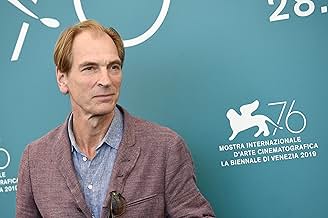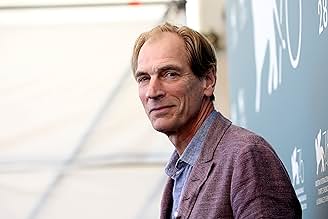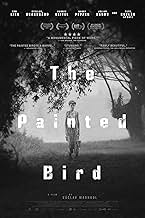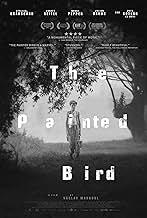CALIFICACIÓN DE IMDb
7.3/10
8.3 k
TU CALIFICACIÓN
Un joven judío busca refugio durante la Segunda Guerra Mundial, donde se encuentra con muchos personajes diferentes.Un joven judío busca refugio durante la Segunda Guerra Mundial, donde se encuentra con muchos personajes diferentes.Un joven judío busca refugio durante la Segunda Guerra Mundial, donde se encuentra con muchos personajes diferentes.
- Dirección
- Guionistas
- Elenco
- Premios
- 24 premios ganados y 24 nominaciones en total
Nina Sunevic
- Marta
- (as Nina Shunevych)
Marika Sarah Procházková
- Woman #1
- (as Marika Procházková)
Opiniones destacadas
Heavy. It's a series of chapters displayed by a photography both stunning and merciless. Human beings here are foundamentally cruel (with a couple of exceptions) and cruelty flows from the oppressor to the oppressed. The movie reminds us about that.
The ending has being discussed, but I think that, just maybe, the protagonist can still hope for a better future.
It's an eastern european movie at its core: raw, uncompromising, brutal, dim, hopeless and honest.
Brutality actually lead to several people leaving the screening I attended to at Venice 76. Here, this movie was labeled as '14+' but I believe it can be easily rated NC-17. The brutality of this movie includes some very graphic gore (although it's mostly present in the first half of the movie) and sexual-related violence (mostly implied but persistent throughout the film). I believe that, as of on-screen depiction of violence, this film probably outranks Schindler's List (although It isn't as vast scaled as Spielberg's film).
Stylistically, this film uses mostly the visual medium rather than conversations to provide information to the viewer. Dialogue becomes secondary at a point where the main character maybe utters a couple of lines throughout the movie, and some of the characters he meets with are entirely silent (Skasgard's character, for example).
The film has a very precise structure: it is made up of 8 chapters, each entitled after a character that the kid meets with, and each chapter reaches a moment when the screen fades to black. After that, a sort-of connective sequence displays the events that lead the kid to change his whereabouts. Among the characters he meets, the audience might recognize Alexander Skasgard, but also Harvey Keitel (in an entirely czech-speaking role) as well as Barry Pepper and german actor Udo Kier.
I wouldn't say that The Painted Bird is a holocaust or ww2 movie, or better, it isn't only that. Thematic elements that relate to either the Holocaust or the War, with the exception of a german plane seen early on, come up only after around one hour in-movie. Before that, whatever happens is mostly related to a strongly rural and superstitious society.
The Painted Bird pays implicit homage to several Eastern European films. The opening sequence mimics the one seen in Jan Nemec's "Diamonds of the Night", a lot of settings remind Elem Klimov's "Come and See" and Tarkovsky's "Ivan's Childhood", the overall fatalist tone reminds strongly of Bela Tarr's films.
It is an outstanding accomplishment, and I sincerely hope that this movie, despite its graphic content, receives enough recognition.
Brutality actually lead to several people leaving the screening I attended to at Venice 76. Here, this movie was labeled as '14+' but I believe it can be easily rated NC-17. The brutality of this movie includes some very graphic gore (although it's mostly present in the first half of the movie) and sexual-related violence (mostly implied but persistent throughout the film). I believe that, as of on-screen depiction of violence, this film probably outranks Schindler's List (although It isn't as vast scaled as Spielberg's film).
Stylistically, this film uses mostly the visual medium rather than conversations to provide information to the viewer. Dialogue becomes secondary at a point where the main character maybe utters a couple of lines throughout the movie, and some of the characters he meets with are entirely silent (Skasgard's character, for example).
The film has a very precise structure: it is made up of 8 chapters, each entitled after a character that the kid meets with, and each chapter reaches a moment when the screen fades to black. After that, a sort-of connective sequence displays the events that lead the kid to change his whereabouts. Among the characters he meets, the audience might recognize Alexander Skasgard, but also Harvey Keitel (in an entirely czech-speaking role) as well as Barry Pepper and german actor Udo Kier.
I wouldn't say that The Painted Bird is a holocaust or ww2 movie, or better, it isn't only that. Thematic elements that relate to either the Holocaust or the War, with the exception of a german plane seen early on, come up only after around one hour in-movie. Before that, whatever happens is mostly related to a strongly rural and superstitious society.
The Painted Bird pays implicit homage to several Eastern European films. The opening sequence mimics the one seen in Jan Nemec's "Diamonds of the Night", a lot of settings remind Elem Klimov's "Come and See" and Tarkovsky's "Ivan's Childhood", the overall fatalist tone reminds strongly of Bela Tarr's films.
It is an outstanding accomplishment, and I sincerely hope that this movie, despite its graphic content, receives enough recognition.
A young Jewish boy and the extreme abuse (quite hideous, alarming at times) and suffering inflicted upon him during WWII by some exceptionally evil and wicked people; slightly loses traction with a few too many frying pan fire cycles to emphasise the point, a shocking experience nonetheless, albeit a very long one. Whether the world still needs this kind of stylisation of the effects of war remains debatable, as does its impact on the memories and emotions already formed over so many years and by so many.
'The Painted Bird' (2019) by Czech director Václav Marhoul is a very difficult film to evaluate. On the one hand, from a cinematic point of view, it is one of the remarkable performances we have seen in recent years - impeccably technical, with many interesting innovations that serve the narrative and messages of the film. It is a film about the Holocaust, an inexhaustible historical and human theme, and more precisely about the destiny of a child in those terrible times - so a story of those with which viewers identify emotionally. Here, however, the issue of this construction also appears. The series of horrors that pervade the screen hardly coexists with the inevitable sensitivity of the spectators when it comes to children's fates on screen. The film is an indictment against a war-torn dehumanised Europe, cruel or at best indifferent to the fate of children separated from their parents by the brutality of war, witnesses and often even victims of the most terrible torture and abuse. There is a complicated history around the film, which adds complexity to the whole edifice and makes it even more difficult to appreciate this film which is both difficult to watch and impossible to ignore as cinematic value and message.
Joska, the main hero, is a Jewish boy on the verge of adolescence, maybe 10-11 years old, who is sent by his parents to an aunt living in a distant place to be saved from deportation. The aunt dies suddenly and the boy embarks alone on a journey home through war-torn Central Europe. On the way he will meet different people, traumatised and impoverished by war. Few will help him, most will exploit, hit, humiliate him. The horrors he will witness and the trials this boy goes through are extreme - from violence and slavery to torture, rape and sexual perversions. Almost the entire repertoire of human cruelty is present in this film. Under these conditions, the boy is in danger to lose his humanity, his sense of good and evil, his appreciation of the value of life, and his identity. Is it still possible for him to recover and return to a normal life after individual traumas of such intensity and proportions? The elliptically beautiful final leaves this question open.
The Europe described by Václav Marhoul contains enough historical hints that allow to locate the story in the film in time in 1944-1945, the last years of World War II, but at the same time many of the scenes take place in a rural setting that could belong to any of the historical periods when Europe was torn apart by wars from the Middle Ages to the present day. Geographical area is treated similarly. The novel that inspired the film is written (in English) by the Polish Jerzy Kosinski, but the producers of 'The Painted Bird' made efforts to avoid a precise location, up to inventing a hybrid language that is used by the villagers in the film, language which combines Czech, Slovak and Polish spoken in central Europe. The cinematography signed by Vladimír Smutný is remarkable, using aesthetically and expressively black and white and the widescreen format of some of Ingmar Bergman's famous films. Much of the film's burden lies on the shoulders of child actor Petr Kotlár, who does not say a word throughout the film, but whose eyes are witnesses to the horrors outside and the suffering inside. The rest of the cast includes a consistent series of portraits, very well made, with realism and naturalism, and played mostly by Czech actors whom we do not know, but also with a few exceptions of celebrities such as Stellan Skarsgård or Harvey Keitel, excellently integrated. As in the masters' films, 'The Painted Bird' is divided into episodes, each bearing the names of some of the human or inhuman people that Joska encounters on his way. Kosinski's novel aroused controversy similar to that now aroused by the film, due to the accumulation of extreme scenes of violence and sex, but also because what was originally presented and promoted as an autobiographical story proved to be rather a synthesis of stories, gathered disparately from the testimonies of several survivors who lived the Holocaust in childhood. In a world where direct witnesses are almost non-existent and where deniers are making their voices heard louder and louder, even works of fiction such as the book and film 'The Painted Bird' must be credible. It is not the description of the extremes that seems problematic to me, but rather their gathering in a single biography. Lack of credibility also harms the emotional involvement of viewers. The temporal and geographical generalisation introduced in the film solves, I think, only partially this problem.
Joska, the main hero, is a Jewish boy on the verge of adolescence, maybe 10-11 years old, who is sent by his parents to an aunt living in a distant place to be saved from deportation. The aunt dies suddenly and the boy embarks alone on a journey home through war-torn Central Europe. On the way he will meet different people, traumatised and impoverished by war. Few will help him, most will exploit, hit, humiliate him. The horrors he will witness and the trials this boy goes through are extreme - from violence and slavery to torture, rape and sexual perversions. Almost the entire repertoire of human cruelty is present in this film. Under these conditions, the boy is in danger to lose his humanity, his sense of good and evil, his appreciation of the value of life, and his identity. Is it still possible for him to recover and return to a normal life after individual traumas of such intensity and proportions? The elliptically beautiful final leaves this question open.
The Europe described by Václav Marhoul contains enough historical hints that allow to locate the story in the film in time in 1944-1945, the last years of World War II, but at the same time many of the scenes take place in a rural setting that could belong to any of the historical periods when Europe was torn apart by wars from the Middle Ages to the present day. Geographical area is treated similarly. The novel that inspired the film is written (in English) by the Polish Jerzy Kosinski, but the producers of 'The Painted Bird' made efforts to avoid a precise location, up to inventing a hybrid language that is used by the villagers in the film, language which combines Czech, Slovak and Polish spoken in central Europe. The cinematography signed by Vladimír Smutný is remarkable, using aesthetically and expressively black and white and the widescreen format of some of Ingmar Bergman's famous films. Much of the film's burden lies on the shoulders of child actor Petr Kotlár, who does not say a word throughout the film, but whose eyes are witnesses to the horrors outside and the suffering inside. The rest of the cast includes a consistent series of portraits, very well made, with realism and naturalism, and played mostly by Czech actors whom we do not know, but also with a few exceptions of celebrities such as Stellan Skarsgård or Harvey Keitel, excellently integrated. As in the masters' films, 'The Painted Bird' is divided into episodes, each bearing the names of some of the human or inhuman people that Joska encounters on his way. Kosinski's novel aroused controversy similar to that now aroused by the film, due to the accumulation of extreme scenes of violence and sex, but also because what was originally presented and promoted as an autobiographical story proved to be rather a synthesis of stories, gathered disparately from the testimonies of several survivors who lived the Holocaust in childhood. In a world where direct witnesses are almost non-existent and where deniers are making their voices heard louder and louder, even works of fiction such as the book and film 'The Painted Bird' must be credible. It is not the description of the extremes that seems problematic to me, but rather their gathering in a single biography. Lack of credibility also harms the emotional involvement of viewers. The temporal and geographical generalisation introduced in the film solves, I think, only partially this problem.
This is like a gift giver that just keeps on giving. Never once throughout the almost three hour run time was I bored. I was captivated from the very first minute right up until the final fade out.
We follow a young Jewish boy trying to survive amidst the chaos of World War II. His luck is horrible and he is subjected to a series of abuses and abusers.
Stay with him, the Painted Bird pays off and will linger in your mind long after you've seen it.
9/10
We follow a young Jewish boy trying to survive amidst the chaos of World War II. His luck is horrible and he is subjected to a series of abuses and abusers.
Stay with him, the Painted Bird pays off and will linger in your mind long after you've seen it.
9/10
¿Sabías que…?
- TriviaIn the 1960s, writer Jerzy Kosinski had become famous in Manhattan literary circles for his astonishing tales about the brutalities he had allegedly suffered during the Second World War. Abandoned by his parents at the age of six, he claimed he had roamed the countryside alone, witnessing rape, murder, and incest, constantly fearing for his life. Kosinski turned those stories into his first novel, "The Painted Bird", which, for a time, was considered a major work of Holocaust literature. Kosinski's claims were later debunked when it was revealed that he and his parents had all been sheltered by religious Poles who had never handed him over to the Nazis.
- ErroresAfter the old man died, Lubina rolled him face down in his grave. The next shot he lies face up.
- ConexionesFeatured in CT na MFF Karlovy Vary 2019: Nabarvené ptáce (2019)
- Bandas sonorasFür Elise
Music by Ludwig van Beethoven
Selecciones populares
Inicia sesión para calificar y agrega a la lista de videos para obtener recomendaciones personalizadas
- How long is The Painted Bird?Con tecnología de Alexa
Detalles
- Fecha de lanzamiento
- Países de origen
- Sitios oficiales
- Idiomas
- También se conoce como
- Painted Bird
- Locaciones de filmación
- Productoras
- Ver más créditos de la compañía en IMDbPro
Taquilla
- Presupuesto
- CZK 175,000,000 (estimado)
- Total en EE. UU. y Canadá
- USD 1,460
- Fin de semana de estreno en EE. UU. y Canadá
- USD 452
- 19 jul 2020
- Total a nivel mundial
- USD 659,535
- Tiempo de ejecución2 horas 49 minutos
- Color
- Mezcla de sonido
- Relación de aspecto
- 2.39 : 1
Contribuir a esta página
Sugiere una edición o agrega el contenido que falta

Principales brechas de datos
What is the streaming release date of The Painted Bird (2019) in Australia?
Responda






























